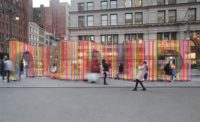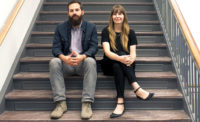In 2007, Harvard GSD students Nancy Hou and Josh de Sousa decided to take their three-year relationship to the next level. The couple enjoyed supporting one another during their undergraduate coursework at Cornell and their first jobs, but they had not designed together until a Bjarke Ingels–led class challenged them to invent a new building type for Dubai. If Hou and de Sousa today—both 34 and married for the past year—remember that proposal (a hybridized resort, desalinization plant, and farm) with a chuckle, they remain grateful for the lesson in collaboration. “What we produced as a team was better than what we could do separately,” de Sousa says.
So there was no hesitation in 2010 to launch a studio in Ecuador, where Hou’s restaurateur parents requested creative direction for a new spot called Dim Sum Bar. Although stably employed in recession-era New York—de Sousa at Joel Sanders Architect and Hou at Stephanie Goto—they packed their bags for Quito.
Hou says of Dim Sum Bar, “We had to work with a lot of existing conditions,” among them prepurchased chairs, a minefield of structural columns, and her father’s mandate “that it has to feel like a Chinese restaurant.” Following the local custom of design-build delivery, they also served as general contractor on the project. They found solutions that overcame the multiple limitations—a series of partitions provide organizational logic, accommodate a local preference for private dining, and evoke traditional Chinese doors, for example. Hou de Sousa also used CNC fabrication to create the screens, and then painted the perforations to spell out the restaurant name.
Hou’s parents then tapped the designers for their next restaurant, Happy Panda. The architects continued their design explorations by digitizing the 12th-century Chinese scroll painting Qingming Shanghe Tu to make wallpaper and shaping the ceiling into an inverted pagoda with CNC-cut plywood and muslin. “It was a completely new education in construction and materiality,” de Sousa says of the two projects.
Dim Sum Bar and Happy Panda transformed a single trip into three years of steady business with other clients, but New York proved irresistible, and Hou de Sousa resettled there in late 2013. Residential renovations paid the bills initially and, in time, competitions presented a creative outlet as well as a marketing channel for the couple, who otherwise blanch at self-promotion.
Submitting proposals paid off almost immediately. For the Folly Program and City of Dreams contests conducted in 2015 for New York’s Socrates Sculpture Park and Governors Island, respectively, Hou de Sousa earned shortlist positions by repurposing plastic shopping bags as skins for temporary pavilions. In the span of one week this spring, the studio triumphed in another pair of competitions. Raise/Raze reassembled several hundred thousand plastic balls—first used in a ball pit installation at the National Building Museum last year—into a modular block system inside a former trolley station in Washington, D.C. And this year’s Folly Program victory, on display through December, attaches a lumber space frame to a shipping container already on-site. Scrap material salvaged from the Socrates property rests within the exposed structure like shingles.
Hou and de Sousa attribute their recent achievements to their attention to constructability and budget—lessons learned in Quito, which are being applied to three Manhattan apartments currently at or near completion. The partners also conjecture that the participatory nature of their designs helped secure their recent wins: for Raise/Raze, visitors could reconfigure the plastic modules into whatever seating or sculpture they imagined, and the Socrates installation serves purposes ranging from shelving to shelter from the elements. “Right now, we think that flexible, interactive systems can help architecture remain relevant in an accelerating world,” de Sousa says. Functioning more as systems than objects, the projects, he says, “mute our own voices and pass the microphone to the public.”








Post a comment to this article
Report Abusive Comment